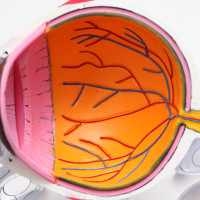Glaucoma - A Silent Sight Killer
02. 12. 2022
Untreated glaucoma can lead to loss of vision
Glaucoma is a multifactorial eye disease characterised by progressive degeneration of ganglion cells of the retina (neuropathy) and causes irreversible loss of the field of view. This leads to blindness as the optic nerve is responsible for bringing comprehensive information about images that appear in our eyes. Glaucoma is one of the leading causes of blindness worldwide, disproportionately affecting more women than men and it tends to be more common in the Asian population. The name glaucoma comes from the Greek word glaukos, which means “the colour of the sea”.
Signs and symptoms of glaucoma
Even now, the aetiology of glaucoma is misunderstood and seems to be a mystery. However, some risk factors contributing to glaucoma have been identified, including age, family history, increased intraocular pressure (IOP), existing optic nerve damage, reduced corneal hysteresis, myopia, diabetes, and pseudoexfoliation. In glaucoma, the degeneration of the optic nerve begins on the periphery and advances to the centre of the eye, resulting in a hazy appearance. The Aqueous humor is produced by the secretion of the ciliary body, which is carried out by trabecular meshwork and partly by uveoscleral outflow (10%). The balance between the inflow and outflow of aqueous humor determines the IOP levels. Excessive inflow or obstruction in the aqueous humor drainage through the iridocorneal angle (juxtacanalicular tissue or trabecular meshwork/Schlemm's canal) leads to an increase in IOP, which can cause damage to the optic nerve. The exact relationship between increased IOP and glaucoma is not entirely known.
Glaucoma in numbers:
- Approximately 2.7 million people in the United States have been diagnosed with glaucoma.
- Around 6.7 million people around the world are affected by the loss of vision in both eyes.
- Glaucoma disproportionally more often affects women and the Asian population.
- 67 million people around the world suffer from glaucoma.
Types of glaucoma
Glaucoma does not come only in one form, but several. For this purpose, it is best to understand that it's classified as a group of eye diseases. It is divided into two main categories – with an open angle and a closed angle, depending on iridocorneal angle. Other types of glaucoma include normotensive, congenital (not developing eye drainage canal) and secondary glaucoma.
- Open-angle glaucoma
It is characterized by a blockage of the drainage channel without physical changes of the iridocorneal angle. It occurs in a longer time frame and it may be more difficult for physicians to diagnose it if the patient is not sent directly for the glaucoma examination.
- Closed angle glaucoma
It is characterized by a close angle between the iris and the cornea through which the fluid escapes the trabecular meshwork and causes occlusion of the aqueous humor drainage. The increase in intraocular pressure occurs much faster. In this form of glaucoma, patients may suffer from extremely severe headaches.
In both types of glaucoma, the drainage of the aqueous humor is blocked, which leads to the inability to regulate the IOP. Patients with normal or low glaucoma stress have normal IOP, but nonetheless, develop visual nerve damage resulting in loss of vision. Secondary glaucoma develops as a result of eye damage or trauma.
Early detection of glaucoma can help reduce the risk of eye damage and related morbidity!
Modern and classic strategies of glaucoma treatment
Several strategies were developed to detect glaucoma in its early stages and to start treatment early.
- The classical treatment strategy is aimed at reducing ocular hypertension, because the increase in IOP is considered a major risk factor. It initiates the development of open-angle glaucoma with normal tension.
- The modern approach initiates therapy for the treatment of IOP with the prescription of topical prostaglandins, Rho kinase inhibitors, α- or β-blockers, carbonic anhydrase inhibitors, nitric oxide (no) donors or their combinations.
In severe conditions of ocular hypertension - when treatment with topical drugs does not reduce IOP - a clinician will turn to laser surgery and eventually will perform a trabeculectomy if IOP is not adequately regulated. In fact, drugs that reduce IOP through one or more mechanisms can treat glaucoma. Pilocarpine was the first drug indicated to reduce ocular hypertension. With the discovery and arrival of new ocular hypotensive inhibitors, the number of drainage operations of glaucoma decreased dramatically. Currently, substances lowering the IOP of the anterior chamber which are used, such as prostaglandin analogues, Rho kinase inhibitors, α- or β-adrenergic antagonists, nitric oxide donors (no), are commonly administered via the uveoscleral pathway or are trying to reduce the formation of aqueous humor.
Although several types of topical eye drops are currently available for the treatment of glaucoma, it is still a challenge to establish the most optimal prescription for each patient, since extensive systematic clinical studies of different drug classes are still limited.
 Novinky - výpis všech
Novinky - výpis všech
